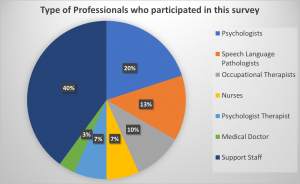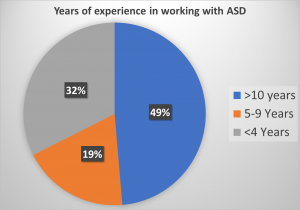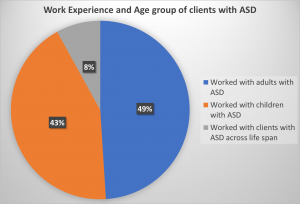
Effect of Covid on Autism
Effect of Covid on Autism
The COVID-19 (C-19) pandemic affected everyone. Especially, Persons with ASD ( autism spectrum disorder) may be at increased risk of experiencing difficulties coping with the impact of C-19 (e.g. due to unexpected changes to usual activities and routines, and the general sense of uncertainty). The Effect of Covid on Autism in pandemic has a detrimental psychological and mental health impact, according to earlier studies. Therefore, this preliminary study gathered the perspectives of health and social care professionals and researchers about:
- Vulnerability factors for coping with the pandemic
- Impact of the pandemic
- Service Provision during the pandemic
- Interventions to support re-integration during and post-pandemic
Read the original article
Why was this study on persons with ASD conducted?
- The views of clinicians and researchers to address these aims is important as they have a working knowledge of service provision before C-19.
- Importantly, they can offer insights into how services can be adapted currently and prospectively.
An online survey was conducted among professionals working with persons with ASD. The survey questionnaire comprised of questions with Likert-scale rating and free responses to the 4 factors mentioned above. Quantitative data were analyzed descriptively, and qualitative data thematically. It’s significant to note that, despite having an impact on society as a whole, the COVID-19 pandemic may not have an Effect of Covid on Autism on everyone’s mental health.
Firstly, who answered this online survey?
Secondly, what experience with ASD did these professionals have?
Lastly, what about the age group of persons with ASD the professionals were treating?
Let’s look at various opinions provided by the professionals for the four factors…..
1. Vulnerability factors for coping with C-19 and lockdown
The professionals were asked to list their views about what were the factors that were affecting persons with ASD due to the C-19 situation and the new normal. Here are some responses
-
Social Communication Impairment
- PwASD struggle to verbalize their thoughts
- Also, communicating by telephone/online was difficult
- Additionally, some ASD comfortable only with face-to-face interactions
- Practitioners may find difficulty in communicating with PwASD
-
Difficulties tolerating uncertainty and coping with change
- PwASD feel anxious due to uncertainity and changing routines
- anxiety about being unable to plan treatment due to uncertainities
- anger, upset and anxiety for not being able to do normal daily routine before C-19
- Unable to use coping stragies in new-normal
-
Neuropsychological Traits
- PwASD prefer knowing rigid set of rules
- Some PwASD experinced difficulties when someone flouted C-19 rules
- some found it difficult to cope with hanging rules
2. Positive and negative impacts of lockdown on persons with ASD
Let’s look at what different professionals working with ASD termed as Positive and Negative Impacts of C-19 on PwASD
-
Impact on PwASD
-
Positive Impacts:
- Not going to less- less anxiety
- managing homework was easier- Less anxiety
- Much needed break from socializing
-
Negative Impacts:
- Loss of specialized services at schools/rehabilitation centers
- changed routine – unsettling
- difficult to learn academic content at home- more distractions
-
-
Impact on Families of persons with ASD
-
Positive Impacts:
- Families grew resilient during C-19
- Families put greater effort to make PwASD accommodate to changes
-
Negative Impacts
- Unable to provide a safe and predictable environment, families were stressed/anxious
-
-
Impact on Professionals working with ASD
- Professionals were affected or recovering from C-19 while working simultaneously
- the constant pressure to get upskilled to use online technology
- uncertainty about jobs/layoffs
- Juggling personal and professional lives while working from home was perceived to be difficult
3. Public Health Response to C-19
-
Information Dissemination
- Lack of accessible information regarding C-19
- Conflicting messages that come through media causing ambiguity
- Frequent changes in legistations causing confusions to PwASD
- Lack of clinical information for prfessionals to deal with PwASD during the pandemic
-
Social Distancing Measures
- Some PwASD were happy with Social Distancing which reduced their social anxiety
- Some of them did not like the new change
-
PPE
- PwASD percieved a Lack of and Inconsistent use of PPE
- Staff could not be trained to manage anxiety of PwASD towards PPEs
- Staff thought that PwASD may not be able to understand and tolerate healthcare workers usage of PPEs
4. Service Provision for persons with ASD during the Pandemic
It was noted that professionals reported disruption of services to PwASD during the pandemic. A total of 27% of professionals reported mild disruptions, 65% reported major disruptions and 8% reported complete loss of services to PwASD.
-
Infrastructure and Staffing
- Problems faced were
- loss of direct appointments
- staff shortage
- redeployment of staff
- trouble adapting to telerehabilitation methods
-
Evidence-based vs Clinically Pragmatic approach
- Professionals found it difficult to decide between informal methods of testing during a pandemic or to wait till restrictions were lifted.
- Additionally, they feared the loss of quality of services
- Also, they reported of lack of guidance
- Finally, changes during the pandemic led to internal conflict between team members because of lack of guidance
-
Advantages and Constraints of telehealth
-
Advantages
- Particularly, some PwASD felt tele-mode to be minimally anxiety-provoking
- Preferred this mode if they had knowledge of operating devices like mobile or laptops
-
Constraints
- Some PwASD found these methods confusing
- A few of them refused to do online therapy
- Other PwASD preferred audio-only mode
-
Professionals who participated in this survey listed certain considerations for telerehabilitation. General considerations relevant to autistic individuals, their families, and professionals
- Firstly, Can prove efficient (e.g. saves on time and travel)
- Reduces costs (e.g. for travel)
- Requires IT equipment, software, skills and internet connection
- Can be difficult to observe and interpret non-verbal cues
- Can feel an intense method of communication
- However, it requires focused and sustained attention
Patient-related factors
- Can be a difficult method of input to understand (e.g. for young children)
- Can be anxiety-provoking
- Some Persons with ASD may prefer audio, rather than visual communication
- It might result in avoidance (e.g. easy to leave the room)
- May find it difficult to process information
- Unable to use tactile forms of communication
Family-related factors
- Requires time
- Requires privacy
Professional-related factors
- Can result in ‘Zoom fatigue’
- May lead to a blurring of professional and personal boundaries (if working from home)
- However, it requires a suitably confidential space to work
Treatment considerations
- Minimal evidence base for telehealth in autism
- Difficult to incorporate aspects of standard psychological interventions (e.g. exposure)
- May not be able to practice strategies in real-world settings
Service-related factors
- Easier to liaise with internal and external agencies (e.g. multi-agency meetings)
- Allows for flexibility in appointment duration and frequency (e.g. shorter, more frequent)
- Lack of clear policies and guidance
- Lack of IT infrastructure (e.g. cannot receive/reply to emails from certain providers)
- May not be possible to provide some aspects of standard assessment or treatment
5. Inequalities in Service Provision during Pandemic
Professionals reported that there were the following inequalities in service provision during the pandemic:
- ASD diagnostic pathways were hampered during the pandemic
- Adequate referrals could not be made due to closed educational institutes
- Remote working resulted in delayed diagnostic processes
- However, Not all PwASD had access to avail telerehabilitation
- Lastly, Telerehabilitation was difficult for PwASD with other comorbidities
Looking into the future for persons with ASD
The participants felt “This may be a really good opportunity to make the world a more autism-friendly place”. As a result, it is important to examine people with ASD for vulnerabilities, psychological consequences, educational outcomes, leisure activities carried out at home, work status, and the pandemic’s Effect of Covid on Autism population.
Based on the themes discussed above the participants listed certain important factors to be considered to make things better for PwASD.
- Change of Ethos
- Evaluate needs on Individual Basis
- Importantly, look for opportunities to make the world a better place for PwASD
- Research Implications
- Additionally, study what helps families cope under special circumstances
- Emphatically, Reshape Service Provision
- Making information accessible
- providing more flexible clinical services
- preparing professionals to cater to PwASD in special circumstances such as C-19
- Living in the new normal
- provide professional assistance to families to cope with new lifestyle post pandemic
- Support for PwASD
- Design and make available more support groups for PwASD
- Lastly, Help them understand new regulations and new ways of living
- “Interventions for children and adolescents with stuttering” - April 7, 2023
- What is Speech Therapy and its effect? - December 21, 2022
- Dysphagic disorder in a cohort of COVID-19 patients - December 13, 2022




Leave a Comment
(0 Comments)